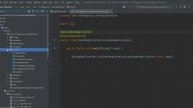String Conversion In Python | Python 4 You | Lecture 176
In Python, string conversion refers to the process of changing data from its original type to a string. This is a common operation when you want to represent data as text or when you need to concatenate different types of data into a single string. Python provides various methods and techniques for converting different types of data into strings. In this guide, we'll explore different aspects of string conversion in Python.
1. Converting Other Data Types to Strings:
Python provides a built-in function called str() that can be used to convert various data types to strings. Here are some examples:
python code
# Converting an integer to a string
number = 42
text = str(number)
print(text) # Output: "42"
# Converting a float to a string
float_num = 3.14
text = str(float_num)
print(text) # Output: "3.14"
# Converting a boolean to a string
is_true = True
text = str(is_true)
print(text) # Output: "True"
The str() function converts integers, floats, booleans, and other data types to their string representations.
2. String Formatting:
String formatting is a powerful way to convert data into strings while controlling the format of the output. Python provides several methods for string formatting, including old-style % formatting and the newer f-strings.
a. Old-Style % Formatting:
This method uses the % operator to insert values into a string using placeholders.
python code
name = "Alice"
age = 30
formatted_string = "My name is %s, and I am %d years old." % (name, age)
print(formatted_string) # Output: "My name is Alice, and I am 30 years old."
b. F-Strings (Python 3.6 and later):
F-strings are a more modern and concise way of formatting strings. They allow you to embed expressions directly within string literals.
python code
name = "Bob"
age = 25
formatted_string = f"My name is {name}, and I am {age} years old."
print(formatted_string) # Output: "My name is Bob, and I am 25 years old."
3. Concatenating Strings:
String concatenation is a way to combine multiple strings into a single string. This can be achieved using the + operator.
python code
first_name = "John"
last_name = "Doe"
full_name = first_name + " " + last_name
print(full_name) # Output: "John Doe"
You can also use the join() method to concatenate strings from a list or tuple.
python code
words = ["Hello", "world"]
sentence = " ".join(words)
print(sentence) # Output: "Hello world"
4. Converting Data Types to Strings in Output:
Sometimes, you may want to convert data to strings directly when printing or formatting output. This can be achieved using the str() function within the print() function or string formatting.
python code
age = 27
print("Age: " + str(age))
# Output: "Age: 27"
5. Handling Special Characters:
When working with strings, you may need to include special characters like line breaks or tabs. You can represent these characters in strings using escape sequences.
python code
# Newline character
multiline_text = "Line 1\nLine 2"
print(multiline_text)
# Output:
# Line 1
# Line 2
# Tab character
indented_text = "Text before\tTab\tText after"
print(indented_text)
# Output: "Text before Tab Text after"
6. Custom String Conversion Functions:
In some cases, you may need to create custom functions to convert specific data types into strings. You can define functions that return strings and use them for conversion.
python code
def custom_converter(data):
# Custom logic for converting data to a string
return str(data)
result = custom_converter(123)
print(result) # Output: "123"
In summary, string conversion in Python is a versatile and straightforward process, thanks to the str() function, string formatting techniques, concatenation, and other methods. These tools allow you to manipulate and format data in various ways to represent it as strings for different purposes.#python4 #pythontutorial #pythonprogramming #python3 #pythonforbeginners #pythonlectures #pythonprograms #pythonlatest #rehanblogger #python4you #pythonlatestversion #pythonlatestversion Learn python3.12.0 and latest version of python3.13. If you are searching for python3.13.0 lessons, you are at the right place as this course will be very helpful for python learners or python beginners.
Видео String Conversion In Python | Python 4 You | Lecture 176 автора Python техники
Видео String Conversion In Python | Python 4 You | Lecture 176 автора Python техники
Информация
2 декабря 2023 г. 4:15:04
00:06:24
Похожие видео
















![Secrets & EKS | develeap Tech Tuesday [Hebrew]](http://pic.rutubelist.ru/video/ab/49/ab494c7fa3d4e9662b953b40c05869d9.jpg?size=s)





